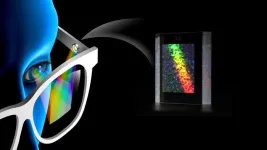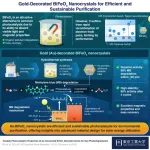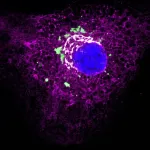(Press-News.org) Setting the stage for a new era of immersive displays, researchers are one step closer to mixing the real and virtual worlds in an ordinary pair of eyeglasses using high-definition 3D holographic images, according to a study led by Princeton University researchers.
Holographic images have real depth because they are three dimensional, whereas monitors merely simulate depth on a 2D screen. Because we see in three dimensions, holographic images could be integrated seamlessly into our normal view of the everyday world.
The result is a virtual and augmented reality display that has the potential to be truly immersive, the kind where you can move your head normally and never lose the holographic images from view. “To get a similar experience using a monitor, you would need to sit right in front of a cinema screen,” said Felix Heide, assistant professor of computer science and senior author on a paper published April 22 in Nature Communications.
And you wouldn’t need to wear a screen in front of your eyes to get this immersive experience. Optical elements required to create these images are tiny and could potentially fit on a regular pair of glasses. Virtual reality displays that use a monitor, as current displays do, require a full headset. And they tend to be bulky because they need to accommodate a screen and the hardware necessary to operate it.
“Holography could make virtual and augmented reality displays easily usable, wearable and ultrathin,” said Heide. They could transform how we interact with our environments, everything from getting directions while driving, to monitoring a patient during surgery, to accessing plumbing instructions while doing a home repair.
One of the most important challenges is quality. Holographic images are created by a small chip-like device called a spatial light modulator. Until now, these modulators could only create images that are either small and clear or large and fuzzy. This tradeoff between image size and clarity results in a narrow field of view, too narrow to give the user an immersive experience. “If you look towards the corners of the display, the whole image may disappear,” said Nathan Matsuda, research scientist at Meta and co-author on the paper.
Heide, Matsuda and Ethan Tseng, doctoral student in computer science, have created a device to improve image quality and potentially solve this problem. Along with their collaborators, they built a second optical element to work in tandem with the spatial light modulator. Their device filters the light from the spatial light modulator to expand the field of view while preserving the stability and fidelity of the image. It creates a larger image with only a minimal drop in quality.
Image quality has been a core challenge preventing the practical applications of holographic displays, said Matsuda. “The research brings us one step closer to resolving this challenge,” he said.
The new optical element is like a very small custom-built piece of frosted glass, said Heide. The pattern etched into the frosted glass is the key. Designed using AI and optical techniques, the etched surface scatters light created by the spatial light modulator in a very precise way, pushing some elements of an image into frequency bands that are not easily perceived by the human eye. This improves the quality of the holographic image and expands the field of view.
Still, hurdles to making a working holographic display remain. The image quality isn’t yet perfect, said Heide, and the fabrication process for the optical elements needs to be improved. “A lot of technology has to come together to make this feasible,” said Heide. “But this research shows a path forward.”
The paper, “Neural Etendue Expander for Ultra-Wide-Angle High-Fidelity Holographic Display” was published April 22 in Nature Communications. In addition to Heide and Tseng, co-authors from Princeton include Seung-Hwan Baek and Praneeth Chakravarthula. In addition to Matsuda, co-authors from Meta Research are Grace Kuo, Andrew Maimone, Florian Schiffers, and Douglas Lanman. Qiang Fu and Wolfgang Heidrich from the Visual Computing Center at King Abdullah University of Science and Technology in Saudi Arabia also contributed. The work was supported by Princeton University’s Imaging and Analysis Center and the King Abdullah University of Science and Technology’s Nanofabrication Core Lab.
END
Holographic displays offer a glimpse into an immersive future
2024-04-24
ELSE PRESS RELEASES FROM THIS DATE:
Novel Au-BiFeO3 nanostructures for efficient and sustainable degradation of pollutants
2024-04-24
The need for sustainable and environment-friendly solutions has accelerated the global demand for green and renewable technologies. In this regard, semiconductor photocatalysts have emerged as an attractive solution, owing to their potential in mitigating pollutants and harnessing solar energy efficiently. Photocatalysts are materials that initiate chemical reactions when exposed to light. Despite their progress, commonly used photocatalysts suffer from reduced photocatalytic activity and a narrow operation range within the visible ...
It takes two to TANGO: New strategy to tackle fibrosis and scarring
2024-04-24
Researchers at the Centre for Genomic Regulation in Barcelona and the University of Cologne in Germany have developed a new experimental strategy to tackle scarring and fibrosis. Experiments with patient-derived human cells and animal models showed the strategy was effective, non-toxic and its effects reversible. The findings are published today in the journal Nature Communications.
Scarring occurs from the secretion and accumulation of various components – primarily proteins known as collagens – into the space between individual cells, usually occurring as a response to injury or damage. Excessive collagen secretion can also cause the buildup of fibrotic ...
Researchers aim to analyze pangenomes using quantum computing
2024-04-24
A new collaboration brings together a world-leading interdisciplinary team with skills across quantum computing, genomics, and advanced algorithms. They aim to tackle one of the most challenging computational problems in genomic science: building, augmenting and analysing pangenomic datasets for large population samples. Their project sits at frontiers of research in both biomedical science and quantum computing.
The project, which involves researchers based at the University of Cambridge, the Wellcome Sanger Institute and EMBL’s European ...
Ready and vigilant: immune cells on standby
2024-04-24
When pathogens invade the body, the immune system must react immediately to prevent or contain an infection. But how do our defence cells stay ready when no attacker is in sight? Scientists from Vienna have found a surprising explanation: They are constantly stimulated by healthy tissue. This keeps them active and ready to respond to pathogens. Based on this insight, future medications could be devised to selectively enhance our immune system’s attention. The study has been published in the journal Nature Immunology (DOI: 10.1038/s41590-024-01804-1).
Communication is crucial in immune defence. When ...
Securing competitiveness of energy-intensive industries through relocation: The pulling power of renewables
2024-04-24
“Our new study shows that renewable-scarce countries like parts of the EU, Japan and South Korea could save between 18 to 38 percent in production costs”, explains Philipp Verpoort, scientist at the Potsdam Institute for Climate Impact Research (PIK) and lead author of the study published in Nature Energy. “They could do so by relocating their production of industrial basic materials like green steel and chemicals based on green hydrogen to countries where renewable energy is cheap.” The use of renewable electricity and green hydrogen is ...
CAR T cell therapy targeting HER2 antigen shows promise against advanced sarcoma in phase I trial
2024-04-24
HOUSTON – (April 24, 2024) – Researchers at Texas Children’s Cancer Center and the Center for Cell and Gene Therapy at Baylor College of Medicine, Texas Children’s Hospital and Houston Methodist published results of a phase I clinical trial of a novel immunotherapy for high-risk sarcomas in the journal Nature Cancer.
The therapy uses chimeric antigen receptor (CAR) T cells engineered to target the HER2 protein, which is overexpressed on the surface of sarcoma cells. The HEROS 2.0 trial showed that this therapeutic approach is safe and is associated with clinical benefit.
“CAR T cell therapy has been a highly successful strategy for recurrent ...
Social change may explain decline in genetic diversity of the Y chromosome at the end of the Neolithic period
2024-04-24
The emergence in the Neolithic of patrilineal1 social systems, in which children are affiliated with their father's lineage, may explain a spectacular decline in the genetic diversity of the Y chromosome2 observed worldwide between 3,000 and 5,000 years ago. In a study to be published on 24 April in Nature Communications, a team of scientists from the CNRS, MNHN and Université Paris Cité3 suggest that these patrilineal organisations had a greater impact on the Y chromosome than mortality during conflict.
This ...
Aston University research finds that social media can be used to increase fruit and vegetable intake in young people
2024-04-24
The research team asked one group of participants to follow healthy eating accounts and another to follow interior design accounts
After just two weeks, participants following healthy eating accounts ate more fruit and vegetables and less junk food
Even minor tweaks to social media accounts could result in substantial diet improvements in young adults.
Researchers from Aston University have found that people following healthy eating accounts on social media for as little as two weeks ate more fruit and vegetables and less junk food.
Previous ...
A vaccine to fight antibiotic resistance
2024-04-24
Driven by the overuse of antimicrobials, pathogens are quickly building up resistances to once-successful treatments. It’s estimated that antimicrobial-resistant infections killed more than 1 million people worldwide in 2019, according to the World Health Organization.
“There are worries that at the rate things are going, in perhaps 20 or 30 years, few of our drugs will be effective at all,” said Xuefei Huang, a Michigan State University Research Foundation Professor in the departments ...
European Hormone Day 2024: Endocrine community unites to raise public awareness and push for policy action on hormone health
2024-04-24
European Hormone Day 2024: Endocrine community unites to raise public awareness and push for policy action on hormone health
European Hormone Day returns for the third year today, 24 April 2024, putting a spotlight on the vital role of hormones in chronic diseases such as diabetes, thyroid disorders, cancer and obesity, as well as many rare diseases.
The European Society of Endocrinology (ESE), the European Hormone and Metabolism Foundation (ESE Foundation), and partners from key groups and organisations across Europe and beyond will join forces to highlight simple steps we can all take towards better hormone health.
This builds on the success of the previous ...






